Last Updated on May 4, 2025 by Kittredge Cherry
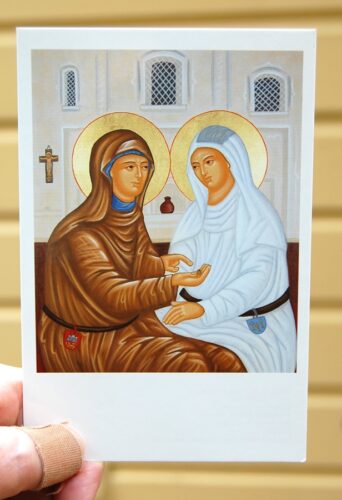
Julian of Norwich is a medieval English mystic who celebrated “Mother Jesus” and had important relationships with women. Her feast day, May 8, always falls near Mother’s Day in the United States.
She had some queer ideas about God, shared her hermit’s cell with a woman, and spent many days communing with another powerful woman mystic, Margery Kempe. Julian is also listed with LGBTQ saints because of her genderbending visions of Jesus and God. She wrote, “As truly as God is our Father, so truly is God our Mother.”
Her discussions of Jesus as a mother sound radical even now, more than 600 years later. Her omnigendered vision of the Trinity fits with contemporary feminist and queer theology.
Mother’s Day is also a great time to honor mothers whose love for their LGBTQ children helped launch organizations such as Parents, Families, and Friends of Lesbians and Gays (PFLAG), founded by Jeanne Manford and Adele Starr.
 Julian of Norwich (c.1342-1416) is the first woman to write a book in English. The book, “Revelations of Divine Love
Julian of Norwich (c.1342-1416) is the first woman to write a book in English. The book, “Revelations of Divine Love,” recounts a series of 16 visions or “showings” that she experienced from May 8-13, 1373, during a severe illness when she was 30 years old. Just having mystical experiences is rather queer because it goes beyond standard ways of knowing. The book includes Julian’s most famous saying, “All shall be well and all shall be well and all manner of things shall be well” — words spoken to her by God in one of Julian’s visions.
After her recovery Julian went on to become an anchoress, a type of recluse who lives in a cell attached to a church and does contemplative prayer. Becoming an anchoress involved an impressive ceremony with a requiem mass before the doorway was literally sealed with bricks. Her hermit’s cell was at the Church of St. Julian in Norwich. The cell had three windows, a church window for viewing worship and taking communion, a window for daily life, and a window to the street for communicating with the world. She became known throughout England for the spiritual counseling that she gave there.
Little is known about Julian, but she was probably born in 1342 in Norwich and lived there for her whole life. She probably came from a wealthy family that provided financial support for her life at the anchorage.
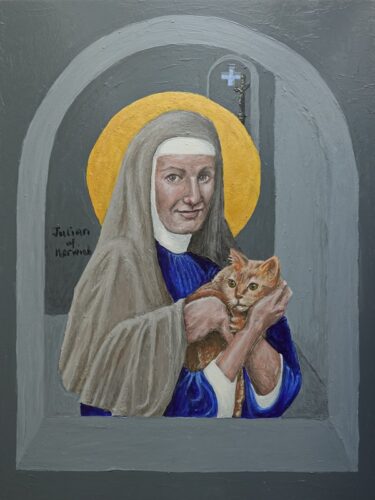
Julian of Norwich and her cat by Tobias Haller.
Julian was famously allowed to share her room was a cat — officially for the practical purpose of keeping it free from rats and mice. Many believe she developed a friendship with her cat companion. She has been depicted with her cat by many artists including frequent Q Spirit at least two whose work appears frequently at Q Spirit: Tobias Haller and Doug Blanchard.
Julian had important relationships with women
Julian lived as a recluse in a hermit’s cell, but she was not as isolated as is often supposed. A cat was not her only companion. A room for a servant was often attached to the cell, and in this space the anchoress and her servant form formed a long-term bond. Julian shared her cell at different times with women named Alice and Sarah. These companions are described as her “servant” or “maid.” But history suggests that sometimes a same-sex partner was called a servant to hide from social disapproval of homosexuality. Others whose same-sex “servants” were dearly beloved include the centurion and his “boy”, Boris and his servant George, and Good King Wenceslas and his “page” Podiven. Julian’s live-in companions Alice and Sarah are known because devout patrons gave bequests to them and Julian in their wills, documenting the significance of their relationships.
Julian also had an important relationship with another trailblazing woman writer and mystic, Margery Kempe. They appear together in the image at the top of this post. This queer side of Julian is explored in the chapter “Queer Touch Between Holy Women: Julian of Norwich, Margery Kempe, Birgitta of Sweden, and the Visitation” by scholar Laura Saetveit Miles of the University of Bergen, Norway, in the 2019 scholarly book “Touching, Devotional Practices, and Visionary Experience in the Late Middle Ages.” It “takes a new approach to the well-known meeting between two late-medieval English visionary women, Margery Kempe and the anchoress Julian of Norwich,” thereby revealing “the full transgressive effect of queer touch between women—or even its unspoken possibility,” according to the chapter summary.
When Margery Kempe wrote the first autobiography in English, she described her long and intimate visit in 1413 with Julian, the first woman to write a book in English. Their literary landmarks sound impressive now, but at the time English was the low-ranking local dialect of the common people. Scholars used Latin, and English was in the early stages of replacing French as prestige language of England’s government.
Kempe was in her 40s when she visited the elderly Julian. Kempe was seeking approval for the visions that she received from God. During their many days together, Julian assured Kempe that her visions were genuine and counseled her about spiritual life. They shared their visions and became chosen family, calling each other “sister.”
Here’s how Kempe described their connection in “The Book of Margery Kempe”: “Much was the dalliance that the anchoress [Julian] and this creature [Kempe] had by communing in the love of our Lord Jesus Christ the many days that they were together.” This text is updated from Middle English to modern English, but Miles points out that both “dalliance” and “communing” had a wide spectrum of meanings, from conversation to sexual union. Anchoresses were allowed to have overnight female guests, so it’s possible that Kempe stayed overnight in the cell with Julian.
Some say that Julian entrusted her handwritten book manuscript to Kempe, who preserved it and lent it to close friends to copy and circulate. The printing press was not yet invented. The unpublished manuscripts were carefully preserved by a long and mysterious chain of guardians that included an English convent of Benedictine nuns in France. Women were preserving women’s writing over the centuries, despite harrowing clashes with authorities during the Protestant Reformation and French Revolution. A Benedictine monk published a translation in 1670, but it got little attention. Finally in 1901 Grace Warrack, a Scots Presbyterian, discovered a copy made by French nuns at the British Library, painstakingly copied it by hand, translated it into modern English, and introduced it to an enthusiastic 20th-century audience. Based on gender stereotypes, many readers assumed that the author of such profound spiritual visions must be a man, especially since the name Julian is more common for men. Many of the most popular and best-remembered historical women in the Q Spirit’s LGBTQ Saints series were writers, including Julian, Perpetua, and Hildegard of Bingen.
Julian lived a long life. The date of her death is unknown, but records show that she was still alive at age 73 to receive an inheritance in 1416. She was never formally canonized, but Julian is considered a saint by popular devotion. The Episcopal and Lutheran Churches keep her feast day on May 8.
Julian wrote of God as mother
Julian is considered the first Catholic to write at length about God as mother. Her profound ideas speak powerfully today to women and queer people of faith. A popular theory is that Julian drew on her own personal experience as a mother whose children and husband died in the Black Plague before she became an anchoress.
Here are a few short quotes from Julian’s extensive writings about “Mother Jesus”:
These quotes come from modern English translations of “Revelations of Divine Love” by Elizabeth Spearing and Clifton Wolters
.
Other saints who wrote about God as mother include Aelred of Rievaulx, Bernard of Clairvaux and Anselm of Canterbury.
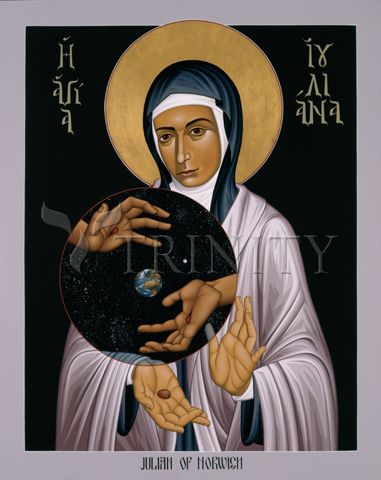
“Dame Julian’s Hazelnut” by Brother Robert Lentz, OFM, Prints available at Amazon or TrinityStores.com
Julian saw God’s love in ordinary life
The sacred feminine is just one of the many revelations that have endeared Julian to the public. She also uses objects from ordinary life to illustrate God’s loving, forgiving nature. For example, in one vision God shows Julian a small object like a hazel-nut in the palm of her hand. Julian writes:
Julian of Norwich in art
Julian is a favorite subject for Tobias Haller, an iconographer, author, composer, and vicar of Saint James Episcopal Church in the Bronx. In addition to the icon at the top of this post, Haller sketched an elderly “Julian of Norwich” was sketched against a lavender background.
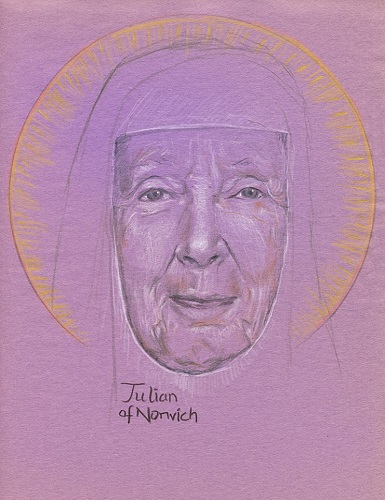
“Julian of Norwich” by Tobias Haller
Haller enjoys expanding the diversity of icons available by creating icons of LGBTQ people and other progressive holy figures as well as traditional saints. He and his spouse were united in a church wedding more than 30 years ago and a civil ceremony after same-sex marriage became legal in New York. He is the author of “Reasonable and Holy: Engaging Same-Sexuality.”

“Julian of Norwich,” a memorial drawing for his cat Betty, by Douglas Blanchard
New York painter Douglas Blanchard shows the saint with the artist’s own cat Betty in a drawing done as a memorial tribute to a beloved feline companion who died in 2013. He includes a favorite quote from Julian:
“He that made all things for love,
by that same love keepeth them,
and shall keep them without end.”
Blanchard is best known for his epic series “The Passion of Christ: A Gay Vision,” which is now available as a book. He teaches art and art history at the Bronx Community College of the City University of New York.
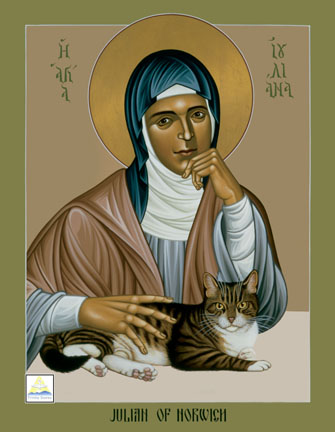
“Julian of Norwich” by Brother Robert Lentz, OFM, Prints available at Amazon or TrinityStores.com
Another icon of Julian and her cat was created by Robert Lentz, a Franciscan friar based in New York. Known for his innovative icons, he was rebuked by the church for painting LGBTQ saints and God as female.
Many important writers have been influenced by Julian, including 20th-century British poet T.S. Eliot. He quotes her in his masterpiece “Four Quartets,” which led to him receiving the Nobel Prize for literature in 1948.
Books about Julian of Norwich
Julian is the inspiration for the queerly creative book “Visions of Divine’s Love: A Drag Theopoetic” by Max Brumberg-Kraus (author) and J. C. A. Freeman (illustrator). It reframes Julian’s 16 visions as 16 poems about the drag queen Divine by a 21st-century professor and film buff — a reimagined Julian — and her unnamed teaching assistant, a novice nun. It was published in 2023 by AC Books.
Recommended book: “Perpetua’s Journey: Faith, Gender, and Power in the Roman Empire (Graphic History Series)” by Jennifer A. Rea (author) and Liz Clarke (illustrator). Published by Oxford University Press, 2017.
Julian of Norwich in song, literature and prayer
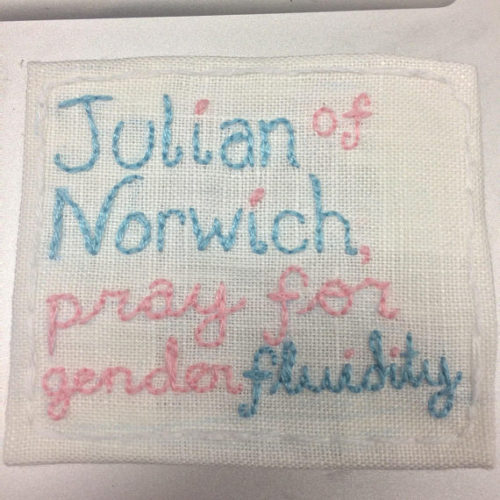
“Julian of Norwich, pray for gender fluidity” by Avery Arden of Sapphic Stiches/NeuroQueerCrafting
Various prayers related to Julian of Norwich are in circulation, including “Julian of Norwich, pray for gender fluidity.” The prayer was hand-sewn onto embroidered patch by artist Avery Smith of Louisville, Kentucky. Smith runs an Etsy shop called Sapphic Stitches that offers a variety of patches on LGBTA+ Christian and other themes.
“LGBTA+ Christians who choose to pray for the intercession of Saints deserve to have patrons whom they trust understand and support them,’ Smith affirms. “Whatever Saint or paired-Saint couple resonates with you as an LGBTA+ Christian can be made into a customizable patch.”
The prayer is incorporated into Q Spirit’s Litany of Queer Saints.
Julian’s famous words are set to music in the song “All Will Be Well” by Meg Barnhouse, a Texas-based Unitarian minister and singer/songwriter. The moving song comes from her album “Mango Thoughts in a Meatloaf Town” and is available on YouTube.
A longer quotation from Julian, again including “All will be well,” was set to music by 20th-century Welsh composer William Matthias in his piece “As Truly as God is Our Father.” it is sung on video by Plymouth Choir of First Plymouth Church, Lincoln Nebraska.

A mug shows Julian with her cat and her best-loved quote: “All shall be well and all shall be well and all manner of things shall be well.” Available from the Drinklings Coffee Mugs Etsy shop.
___
Related links:
Medieval anchoresses found spiritual freedom in tiny cells (uscatholic.org)
___
To read this post in Spanish / en español, go to Santos Queer:
Juliana de Norwich: Celebración de la Madre Jesús (Santos Queer)
To read this article in Italian, go to:
Gesù come madre. La vita e il pensiero di Giuliana di Norwich (Gionata.org)
___
Related links for Mother’s Day:
Jeanne Manford: PFLAG founder loved her gay son
Adele Starr and others: Patron saints for straight allies of LGBTQ people
___
Top image credit:
Hand holding a devotional card credited as follows:
“Icon by Brother Leon of Walsingham
of the English mystics, Julian of Norwich and
Margery Kempe of Lynn,
at S. Michael and All Angels,
Brighton.
Printed by The Postcard Company Ltd. (028) 8224-9222”
Julian appears on the left.
___
This post is part of the LGBTQ Saints series by Kittredge Cherry. Traditional and alternative saints, people in the Bible, LGBTQ martyrs, authors, theologians, religious leaders, artists, deities and other figures of special interest to lesbian, gay, bisexual and transgender and queer (LGBTQ) people and our allies are covered.
This article has evolved and expanded greatly since the first version was posted in May 2011. It was published on Q Spirit in May 2017, was enhanced with new material over time, and was most recently updated on May 3, 2025.
Copyright © Kittredge Cherry. All rights reserved.
Qspirit.net presents the Jesus in Love Blog on LGBTQ spirituality.




















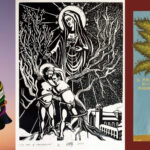

I’m sorry but this is not what Julian was most likely referring to. When the Lord Christ / God is referred to as a “Mother” this is not to be understood from an earthly perspective of gender… It’s a transcendent metaphor that talks about the incredibly parental qualities of God… But not His gender. Christ incarnated as man and in the OT The Lord referred to Himself with male pronouns. If there was as much gender fluidity as some may theorize, I think this would have been revealed to us much more plainly. God bless you though.
Anyone interested in this topic of Jesus as Mother would probably enjoy the book “Jesus as Mother: Studies in the Spirituality of the High Middle Ages” by Caroline Walker Bynum. This other website has a very good write up about this topic, too: https://www.mothergodexperiment.com/jesus-mother-brief-history/
Since God doesn’t have a physical body and hence doesn’t have an actual “gender”, it was fairly common for medieval mystics to describe God using maternal language, which has absolutely nothing to do with transgenderism. Hildegard von Bingen said God told her that the male human psyche was based on the dominant half of God’s “mind” while the female human psyche was based on the other (more passive) half of God’s mind, so in that sense God would have both “male” and “female” attributes but these are all loose metaphors to put the matter in human terms. You’re misinterpreting or deliberately twisting this completely out of context, as usual.
I’m wondering why you have need to chastise the writer of this newsletter? Why not just offer your differing opinion on the subject?
Sounds like you have an axe to grind, maybe with the mystics, maybe with the queers, maybe with your own upbringing or spiritual studies.
Fyi – Medieval mystics, as well as educated and non-educated people of medieval society, readily distinguished between mother and father energy in spiritual discussion.
From your comment, I glean no discernible basis for your claim of the writer ‘deliberately twisting’ anything. And to use Hildegard von Bingen to validate your obnoxiously written theory, she of all people!, made me laugh aloud.
Note to CGesange: I received more comments from you on this post, but I am not approving them because you are violating the rule against repetitive comments. Anyway you have already left a negative comment on almost every article on this website, so you have had plenty of chances to express your opinion. I believe it is fair to allow each commenter to make ONE statement per article. Back-and-forth debate is discouraged. If you don’t like the ideas and policies at Q Spirit, then you are more than welcome to stop visiting this website.